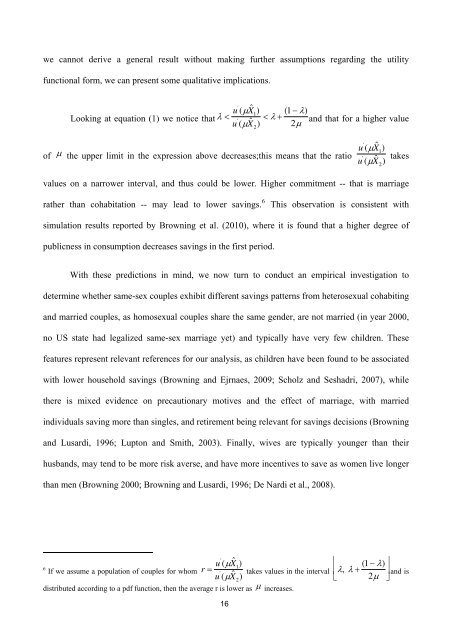Download PDF - Ivie
You also want an ePaper? Increase the reach of your titles
YUMPU automatically turns print PDFs into web optimized ePapers that Google loves.
we cannot derive a general result without making further assumptions regarding the utility<br />
functional form, we can present some qualitative implications.<br />
Looking at equation (1) we notice that λ < u' (μ ˆ X 1<br />
)<br />
u ' (μ ˆ X 2<br />
)<br />
(1 − λ)<br />
< λ + and that for a higher value<br />
2μ<br />
of μ the upper limit in the expression above decreases;this means that the ratio u' (μ ˆ X 1<br />
)<br />
u ' (μ ˆ X 2<br />
) takes<br />
values on a narrower interval, and thus could be lower. Higher commitment -- that is marriage<br />
rather than cohabitation -- may lead to lower savings. 6<br />
This observation is consistent with<br />
simulation results reported by Browning et al. (2010), where it is found that a higher degree of<br />
publicness in consumption decreases savings in the first period.<br />
With these predictions in mind, we now turn to conduct an empirical investigation to<br />
determine whether same-sex couples exhibit different savings patterns from heterosexual cohabiting<br />
and married couples, as homosexual couples share the same gender, are not married (in year 2000,<br />
no US state had legalized same-sex marriage yet) and typically have very few children. These<br />
features represent relevant references for our analysis, as children have been found to be associated<br />
with lower household savings (Browning and Ejrnaes, 2009; Scholz and Seshadri, 2007), while<br />
there is mixed evidence on precautionary motives and the effect of marriage, with married<br />
individuals saving more than singles, and retirement being relevant for savings decisions (Browning<br />
and Lusardi, 1996; Lupton and Smith, 2003). Finally, wives are typically younger than their<br />
husbands, may tend to be more risk averse, and have more incentives to save as women live longer<br />
than men (Browning 2000; Browning and Lusardi, 1996; De Nardi et al., 2008).<br />
6 If we assume a population of couples for whom r = u' (μX ˆ<br />
1<br />
)<br />
⎡<br />
u ' (μX ˆ<br />
2<br />
) takes values in the interval ⎢ λ, λ +<br />
⎣<br />
distributed according to a pdf function, then the average r is lower as μ increases.<br />
13<br />
(1 − λ)<br />
2μ<br />
⎤<br />
⎥ and is<br />
⎦

















